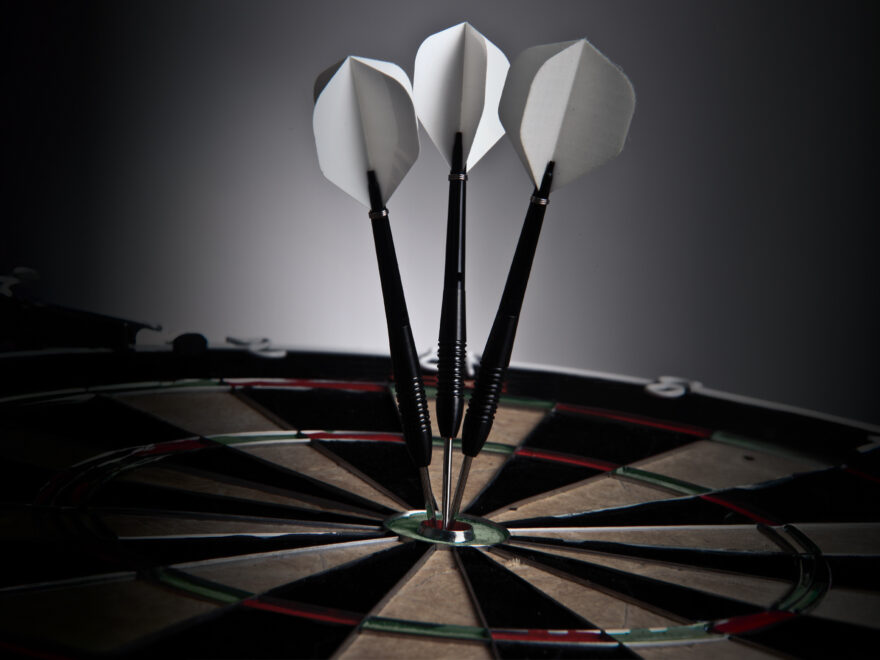I still remember throwing brass barrelled darts with wooden shafts and real feather flights at a wound paper dartboard.
Telling this story to my kids they would ask if any dinosaurs occasionally got in the way, but surprisingly enough this was the 1970’s. These darts were the third iteration of the evolution of the recreational dart. Previously the barrel was also made of wood with a strip of lead wrapped around it for weight to allow for a semblance of controlled flight. The metal barrel was patented in 1906 but surprisingly wood was still commonly used into the ‘50s.
The origin of the game supposedly developed as a pastime for the military between battles in “ye olde England” about the 1300’s using darts imported from France after the concept came from throwing crossbow bolts at the bottom of beer barrels, which makes sense when you consider the amount of beer still consumed at darts matches today and how it developed as a pub game.
The weight of the dart can vary between 11 grams up to 48 grams but 18-24 grams is more commonly used. Brass barrel darts become popular because they could be produced quite cheaply with accurate weight tolerances. As players became more accurate and expected to be able to fit all 3 darts into the bull or treble 20 the barrel diameter became an issue. You can only fit so much brass into a barrel without making it either too fat or too long to be playable, so other metals were tried until eventually Tungsten became the metal of choice the late ‘70s for the best weight to size ratio. Because Tungsten has more than twice the density of brass the barrels could be made much slimmer for the same weight and extra knurling could be cut without needing to add length.
Tungsten is not as readily available as brass, so the darts are a bit more expensive, but it is a lot safer than using Uranium, which weighs about the same, and is even harder to get. If you are wondering what weight dart to buy to start with, 23 grams is most popular among top professionals, though 28 grams is recommended for beginners. If you find an opportunity to try different weights it’s worth having a throw to see how they feel for you.
Traditionally darts have steel tips to allow them to stick into the board. The main concern with steel tipped darts is that they can cause physical damage to objects that get in the way, whether that be a player, scorer, child, pet, or your lounge wall. In 1975 plastic soft tipped darts were invented and have become popular, especially for starting children out on the journey to darting stardom, or as a safer form of the game in pubs. The soft tip darts are particularly useful for general social use in electronic boards as these automatically score for you and the game becomes less dangerous if someone gets a little too competitive after a few beers and bad shots. Another advantage to electronic scoring in these days of potential lockdowns and lots of internet bandwidth is that games can be played with competitors across the world without leaving home. I predict that not too far away we will see a virtual soft tip world cup, if there’s someone out there with the vision to make it happen.
Flights (the feather end) can make a difference to how your darts fly and come in a variety of shapes. When starting out it’s worth just getting a variety of whatever is cheap as you will go through a few with the amount of practice you want to do to gain an acceptable level of scoring proficiency. Once you start honing your skills and want to personalise your darts to your style it’s worth considering the shape and weight of the flights as much as the shape and weight of the barrels. The standard flight will give stability through the air, slimmer shaped flights allow the dart to fly faster and are more suitable for harder throws or lighter darts. The slimmer flights also get in the way less so you can see better what you are aiming for with your 2nd and 3rd darts.
The other part of a dart is the stem or shaft that connects the barrel to the flight. Usually available in 4 different length options and made of nylon, polycarb, or aluminium with either fixed or spinning tops. Spinning tops allow the flight to spin on contact with other darts causing less deflection, but are more expensive.

